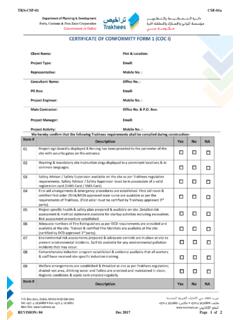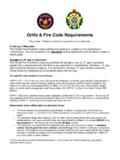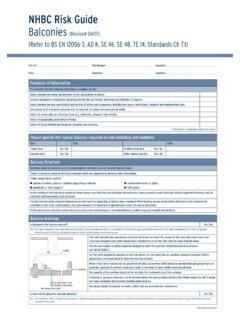Transcription of Regulation DD-45.0 Staircases, Handrails, Ladders …
1 Revision: 01 February 2011 Page 1 of 7 Regulation staircases , Handrails, Ladders & Balconies staircases Handrails Ladders Balconies Revision: 01 February 2011 Page 2 of 7 staircases All the building types that has more than one floor, and whose floor area below 450 square meter or 1400 square meter for the total floor area, shall provide a minimum of one main staircase.
2 Regarding every additional area, from 450 to 950 square meters per floor or from 1400 to 2800 square meter per floor, an additional staircase shall be provided. The clear width of the stair landing shall not be less than the clear width of the stair, and shall not be less than meter for the residential and office buildings, and meter for the public buildings. The minimum clear vertical height from the bottom margin of the landing structure to the pedestrian passageway shall be meter.
3 The maximum number of steps in one single staircase or in one direction shall be less 14 steps. All the steps shall be identical in height and width. Normal staircase is 2R+T = , R= riser and T= tread, 1. maximum R shall be meter 2. minimum T shall be meter The minimum door inward swinging clearance shall be meter from first step. Head room over stairs and landings should not be less than 2000mm measured vertically above the pitch line. Additionally there should be a minimum clearance measured at right angles to the pitch line of at least 1500 mm.
4 A single step is likely to cause a trip and should not be placed across a circulation route. If a single step is used, it should be well lit and be prominently marked by contrasting Colour. Stairs and landings should be provided with protection against falling over the edge of the treads. Guarding height should be no less than 900 mm above the pitch line of the stairs and not less than 1100mm above landings, with the maximum clearance among the vertical rods of the stair railing shall be meter.
5 In addition to guarding, every step with two or more rises should have a continuous handrail to provide guidance and support to those using the stair. Handrails are required to be beside the bottom two steps in a stairway if the stairway is in a public building or is intended for use by disabled people. Handrails should help an individual to regain balance in the event of a fall, and thus reduce the severity of injuries that may result. Treads and landings should have a surface (including the nosing) that does not become slippery in use.
6 Slip resistant strips or inserts should be fitted, they should be fitted as close as possible to the leading edge of the tread and should be of contrasting Colour or brightness. Adequate artificial lighting should be provided on staircase, users should be able to distinguish clearly each step, especially the first and last steps in each flight and wherever changes in Revision: 01 February 2011 Page 3 of 7 direction occur.
7 Two way switching should be provided at the top and bottom of stairs at each floor. Handrails Handrails should be: A. rigid and strong enough to provide adequate support for users B. Comfortable to grip and without sharp projections yet able to provide adequate resistance to hand slippage C. A poor conductor of heat if exposure to heat is likely. D. Stairs and landings should be provided with protection against falling over the edge of the treads. Guarding height should be no less than 900 mm above the pitch line of the stairs and not less than 1100mm above landings, with the maximum clearance among the vertical rods of the stair railing shall be meter.
8 Handrails should be provided on both sides of the stairwell. Where people are likely to be ascending and descending the stair at the same time, , on stairs with a width of 1000mm or more, it is essential to have a handrail on both sides. E. Where public or assembly stairs have a stair width greater than 1800mm, the stair width should be divided by handrails into two or more channels so that all persons using the stair are within reach of a handrail . Ladders General Design Considerations The minimum design live load shall be a single concentrated load of 200 pounds.
9 The number and position of additional concentrated live-load units of 200 pounds each as determined from anticipated usage of the ladder shall be considered in the design. The live loads imposed by persons occupying the ladder shall be considered to be concentrated at such points as will cause the maximum stress in the structural member being considered. The weight of the ladder and attached appurtenances together with the live load shall be considered in the design of rails and fastenings.
10 Metal Ladders and appurtenances shall be painted or otherwise treated to resist corrosion and rusting when location demands. Ladders formed by individual metal rungs imbedded in Revision: 01 February 2011 Page 4 of 7 concrete, which serve as access to pits and to other areas under floors, are frequently located in an atmosphere that causes corrosion and rusting. To increase rung life in such atmosphere, individual metal rungs shall have a minimum diameter of 1 inch or shall be painted or otherwise treated to resist corrosion and rusting.















